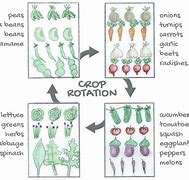The practice of crop rotation began during the Eastern Zhou period in China — 771 to 476 BCE. The Romans used what’s now known as the three-year rotation system while the four-year rotation system appeared in what is now Belgium in the early 16th Century.
In addition to reducing pest problems, rotation enhances the soil health and the levels of nutrients that different types of plants need from the soil.
Gardeners would rotate a vegetable (or vegetable family) so that it grows in a particular place once out of every 3 to 4 years.
The key to successful crop rotation is “all in the family.” For example, even though tomatoes, peppers, eggplant and potatoes look nothing alike, they are in the same botanical family, the nightshades (Solanaceae).
Here are the major family groupings:
- Alliums: Onions, shallots, leeks, and garlic.
- Legumes: Green beans, green peas are soil “fixers” and add nitrogen back to the soil.
- (You can help the process by inoculating the seeds with bacteria from the genus Rhizobia, available from most garden centers or on line.)
- Brassicas: Broccoli, cauliflower, cabbage, kale, Brussels sprouts, turnip greens, radishes, collards, Chinese cabbage, mustard greens, and collards.
- These need nitrogen-rich soil.
- Plant after the legume (bean) family.
- Nightshades: Tomatoes, eggplant, peppers, and potatoes.
- All heavy feeders which need rich soil.
- Affected by the same diseases.
- Never follow tomatoes after potatoes.
- Umbellifers: Carrots, parsnips, fennel, parsley and dill.
- Cucurbits: Zucchini and summer squash, cucumbers, pumpkins and winter squash, melons (watermelon, cantaloupe), and gourds.
- All are heavy feeders that grow best in rich soil.
A three-year crop rotation


A four-year crop rotation


Keeping a Record
- Crop rotation is not as complicated as it sounds, but it can be hard to keep track of.
- Don’t rely on memory alone, particularly if you are growing different amounts of a variety of crops!
- Just roughly sketch your garden and write down what you have planted where and by plant family. (It can also be helpful to keep a list of the variety names.)
